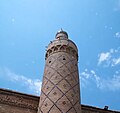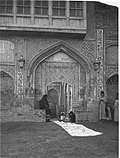
This is a list of mosques in Baghdad from different dynastic periods.
Contents
Baghdad, in Iraq, was once the capital of the Abbasid Caliphate and a center of Islamic advancements. Today, there are 912 Congregational mosques in Baghdad that conduct Friday Prayer, and 149 smaller mosques that only hold regular daily prayers. [1]





























